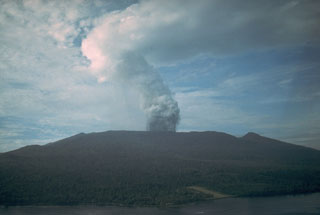Report on Karkar (Papua New Guinea) — 2 January-8 January 2008
Smithsonian Institution / US Geological Survey
Weekly Volcanic Activity Report, 2 January-8 January 2008
Managing Editor: Sally Sennert.
Please cite this report as:
Global Volcanism Program, 2008. Report on Karkar (Papua New Guinea) (Sennert, S, ed.). Weekly Volcanic Activity Report, 2 January-8 January 2008. Smithsonian Institution and US Geological Survey.
Karkar
Papua New Guinea
4.647°S, 145.976°E; summit elev. 1839 m
All times are local (unless otherwise noted)
RVO reported that white vapor emissions from the Bagiai cone in Karkar's inner caldera were observed by a visiting field team during 27-31 December. The resultant white vapor plume was also visible from the mainland. Communities to the W and SW reported hearing roaring noises associated with gas emissions. Images sent to RVO on 11 December indicated that the vegetation on the SE flank was completely withered.
Geological Summary. Karkar is a 19 x 25 km forest-covered island that is truncated by two nested summit calderas. The 5.5 km outer caldera was formed during one or more eruptions, the last of which occurred 9,000 years ago. The steep-walled 300-m-deep, 3.2 km diameter, inner caldera was formed sometime between 1,500 and 800 years ago. Cones are present on the N and S flanks of this basaltic-to-andesitic volcano; a linear array of small cones extends from the northern rim of the outer caldera nearly to the coast. Recorded eruptions date back to 1643 from Bagiai, a pyroclastic cone constructed within the inner caldera, the floor of which is covered by young, mostly unvegetated andesitic lava flows.
Source: Rabaul Volcano Observatory (RVO)

